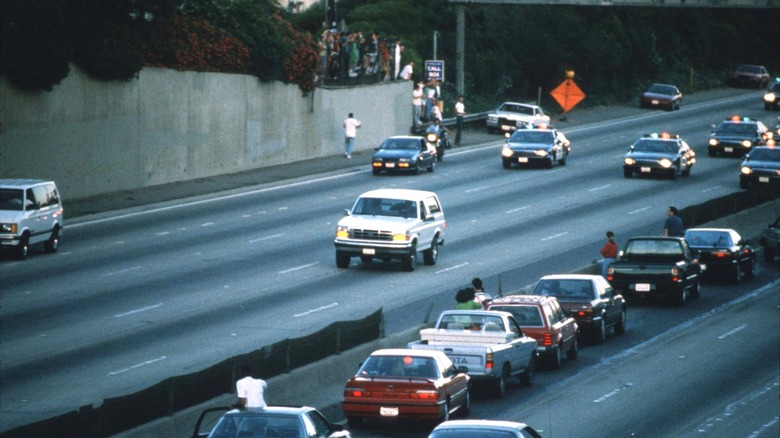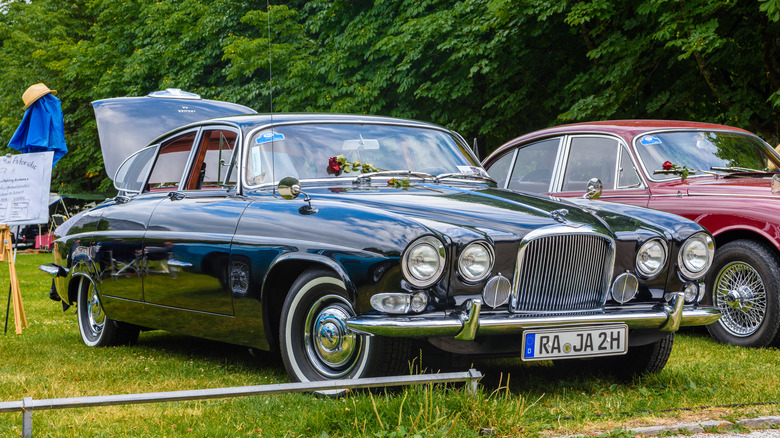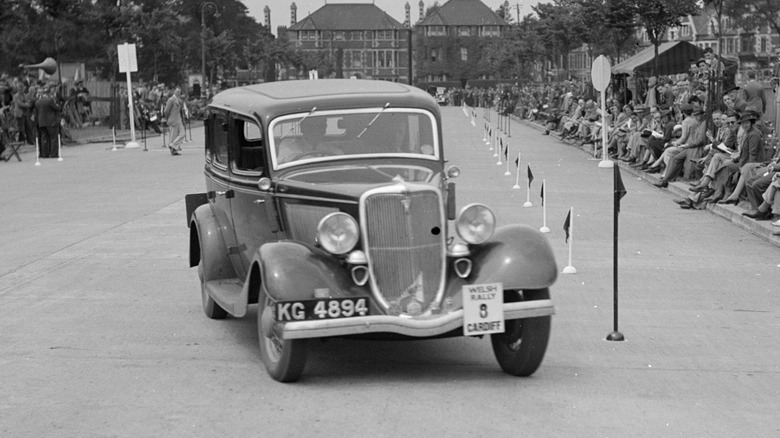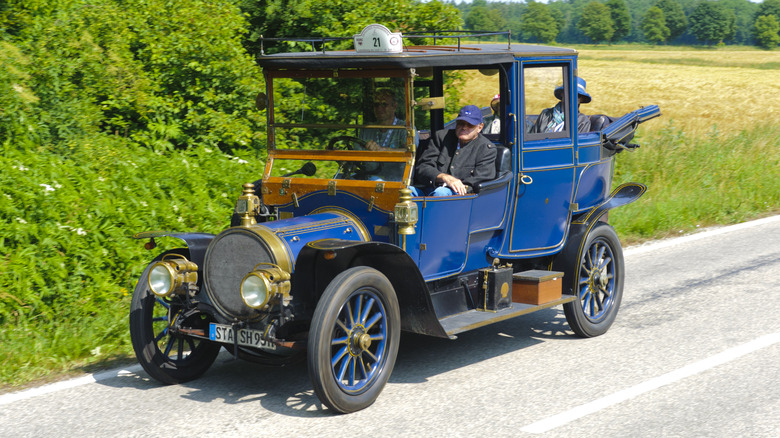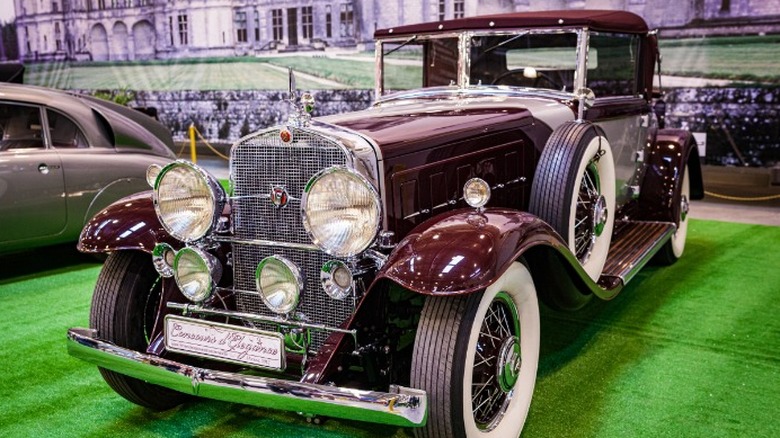The Most Infamous Getaway Cars Of All Time
As long as there have been cars, and as long as there will be cars, criminals will employ them in committing crimes. From the days of robbing stagecoaches and trains, thieves have needed a method to flee the scene. The modern age brought them terrific machines to help evade capture, and as technology has progressed, so have the practices employed by the criminals.
Fast cars have always been a vehicle of choice, from the modified flatheads of the bank robbers and moonshiners of the roaring '20s, to the Jaguars of Britain's most notorious felons of the '60s. Police have also been playing catch-up the whole time, with the introduction of faster special edition police package cars only beginning in the '60s. The cars of some of the most infamous gangsters and thieves are often inextricably linked to their tales of crime, often ending up on display in various museums. The stories of the crimes and their escape cars are fascinating tales that we tell, not to exalt the criminals of the past, but as reminders that crime is an element that will always exist. Here are some of the most infamous getaway cars of all time.
Jaguar 420G
Ronnie and Reggie Kray were celebrities of the British underworld throughout most of the '60s. They were former boxers turned criminals who ran nightclubs in London, and carried on with celebrities who would frequent their establishments and raise their own celebrity in the process. However, they are notorious for being particularly violent, lifelong criminals who had been in and out of prison, even continuing their violent ways while in lock-up (via Car and Classic).
Their cars of choice were Jaguars, and the 420G was one of the models they would be seen in frequently. Their criminal enterprise was known as "The Firm," and Jaguars were the company car. While it was far smaller and less powerful than comparable American cars, in England, it was as elegant and powerful as they came: The legendary Jaguar I-6 was pushing 265 horsepower, and nearly 283 pound-feet of torque (via MotorTrend). The 420G introduced the styling that would be the hallmark look of Jaguars for the next three decades. Most of all, the 420G is a beautiful car that is highly sought after today, regardless of its ties to the underworld of yesterday.
1934 Ford V8
Introduced in 1932, the Ford V8 became one of the most successful engines in the country. It was tough, relatively powerful, and durable. The new V8 came in a car called the Model 18, or Model 40, but it's usually just referred to as the Ford V8; such as the 1934 Ford V8 driven by Bonnie Parker and Clyde Barrow. Like the Model T and Model A, the new Ford V8 was an affordable car with an original price of around $575, depending on the body style. The flathead V8 produced up to 85 horsepower, which was more than the previous 4-cylinder of the model A, and offered generous torque to get these fairly large cars cruising (via AutoTrader).
Bonnie Parker and Clyde Barrow went on a crime spree in the early '30s and remained on the run, robbing banks, gas stations, and retail establishments throughout Oklahoma and Texas. Their connection to a stolen Ford from Pawhuska, Oklahoma led the Bureau of Investigation, the predecessor to the FBI, to issue a warrant and begin a search for the pair and their accomplices. Things came to a head in Louisiana when FBI agents ambushed the pair, resulting in their killings and the stolen Ford being littered with bullet holes. It was one of the most sensational manhunts of its day. In the end, Bonnie and Clyde were responsible for the murders of 13 people (via the FBI).
Ford Bronco
The 1994 highway chase of OJ Simpson by California police brought global attention to the event of a televised police chase. Simpson was scheduled to turn himself in to police as the prime suspect in the murders of his ex-wife Nicole Simpson, and her friend Ron Goldman. When he did not arrive, police got antsy and went to search for him, leading to a two-hour, slow-speed pursuit. The chase ended at Simpson's home where he was taken into custody, and the most spectacular trial of the decade ensued (via Los Angeles Times).
The vehicle in the chase, a white 1993 Ford Bronco, was not OJ's, but his friend's, AL Cowlings', whom some described as Simpson's shadow. The Bronco has forever been inextricably linked to OJ, and often shows up in pop-culture references. OJ also owned a white Bronco, but it had been left at his home, covered in blood, and was later destroyed after the trial concluded. Cowlings' Bronco survives. The Bronco was bought by Simpson's former agent, Mike Gilbert, shortly after the media circus died down, kept out of public view for years. It did pop up on an episode of Pawn Stars, "If the Deal Don't Fit," but a sale failed to materialize. It is somewhat of a memorabilia hot potato. Today, it sits on loan to the Alcatraz East Crime Museum in Pigeon Forge, Tennessee, sitting next to Ted Bundy's VW Bug, per Auto Evolution.
Delaunay-Belleville
Financial gain is not the only motivating factor for criminals. Politics can play a role, and the financial aspect is often intertwined with the political. Such is the case with the Bonnot Gang in the first part of the 20th century. The Bonnot Gang was a group of French anarchists who were essentially crooks with serious grievances against the bourgeois upper-class society. They were notorious for committing crimes of thievery, vandalism, and engaging in general debauchery. In Richard Perry's book, he explains how this group came about due to the vast gap between the ruling class and the workers, as well as the repression by the government of union leaders and tradesmen.
In 1914, the gang stole a Delaunay-Belleville automobile, considered the finest in the world at the time. It was primarily a chauffeur-driven car owned by industrialists and royalty, such as Czar Nicholas II. After obtaining the car and planning out a heist, it was used in what would be considered the first robbery by automobile in history. It was, in essence, the first getaway car. The Delauney-Belleville was chosen partly for its 6-cylinder engine producing 25 horsepower, per SuperCars.net. It was among the biggest and most opulent vehicles on Parisian streets in its day. The gang was eventually brought to justice, but not without having committed more robberies and murders before they were apprehended.
Vauxhall Lotus Carlton
General Motors' presence in Britain is represented by the Vauxhall brand. While it often shared platforms with its American counterparts, many of its models were unique to Europe. During the GM ownership of Lotus, several cars were engineered with the direct help and manufacturing expertise of the boutique sports car maker. One such example of this is the Vauxhall Omega transformed into the Vauxhall Lotus Carlton, a sports saloon that proved to be too fast for the police (via Carscoops).
Thieves in England were known for committing a crime called a ram-raid, in which a car was driven into the front of a shop while thieves ran in to grab whatever loot they could, often jewelry. According to Jalopnik, on November 26, 1993, a group of thieves in a Lotus Carlton terrorized the streets by committing a series of ram-raids. The car is a fairly powerful beast, sporting a 3.6-liter, inline-six with twin Garrett turbos pushing the engine to 377 horsepower, and more than 400 pound-feet of torque. It was the fastest saloon in Britain at the time, and far faster than any of the typical police vehicles. The Lotus continued to be used in raids with thieves getting away with their loot, including £20,000 worth of liquor and tobacco. The thieves and the car were never caught.
Citroën DS
Having a good getaway car is not just a good piece of kit for the baddies; many politicos have had reason to flee a scene over the decades. Such is the case for President Charles De Gaulle of France. He was the target of an assassination attempt in 1962, only escaping narrowly thanks, in part, to his excellent choice of car, a Citroën DS. The assassination attempt was perpetrated by a group called the OAS (translated to Secret Army Organization in English), comprised of various officials who felt betrayed by France's letting go of Algeria, supposedly turning its back on the French-Algerian citizens. De Gaulle and his wife were en route to the Orly airport when gunmen ambushed his convoy, and showered them with bullets. If not for the quick-thinking driver and the sharp handling of the DS, he may have died. The car fled with all four tires shot out, and the rear window shattered (via History).
The DS is one of the all-time favorite classic French autos. It was also a revolutionary machine at introduction. Its suspension remains one of the most sophisticated designs ever built, and is extremely capable. Its adjustable, self-leveling hydro-pneumatic design gives the car an extraordinarily smooth and comfortable ride while retaining tight handling characteristics when needed, per Auto Express. It is also well-appointed in the interior with plush, comfortable seating and unique styling that is hard to ignore. More innovations are spread throughout the car, but its legacy as the car that saved a president is perhaps its highest honor.
Ford Model A
John Dillinger has the honor of showing up on this list twice, with another mention later on. This time, he's included for the car he used during his criminal career, rather than his time escaping it. A troubled individual since his youth, John Dillinger led a gang that left a trail of violence and suffering throughout the Midwest during the early part of the Great Depression. During their crime spree, they robbed banks and police arsenals, often killing police officers who got in the way. Like so many of his peers of the time, Dillinger met his fate at the end of a manhunt, succumbing to multiple gunshot wounds courtesy of the FBI in 1934 (via the FBI)
One of the cars Dillinger is known for using during his crime spree is a 1930 Ford Model A. Successor to the best-selling Model T, the Model A was a huge leap forward toward building a modern car. The controls and operating procedures of the Model A would be familiar to most drivers today, and the cars proved to be highly reliable and durable vehicles. Dillinger escaped a law enforcement raid in the Model A, fleeing Little Bohemia Lodge in Wisconsin. The actual car used by the notorious gangster survives to this day, even taking on a role as a movie car. It showed up in the 2009 film "Public Enemies" with Johnny Depp. It subsequently went up for auction by Barrett Jackson in 2010.
Citroën Traction Avant
French people love their country's unique and quirky cars. French robbery gangs are also fond of their own Gallic machines. So notorious was the Traction Avant with one particular gang, that they became known as the Le Gang des Tractions Avants. The leader of the group, Pierre Loutrel, was a particularly terrible person. Before leading a gang of ruthless criminals in post-war France, he collaborated with Nazis, at one point becoming a member of the Gestapo in occupied France. He made his connections in prison, and escaped to join the Nazis during the chaos of the Geman invasion. He was eventually rejected by the Germans for somehow being too violent, according to Ranker.
Loutrel eventually joined the resistance before organizing a gang that became notorious for their use of the Citroën Traction Avant, the world's first front-wheel-drive car. Germans had commandeered thousands of cars during the occupation, with many of them being Traction Avants. After the war, these cars were readily available along with millions of submachine guns left behind. Loutrel's gang robbed banks in France using the cars and British Sten guns to relieve French financial institutions of as much as $8 million in today's money. The Traction Avant's lack of a driveshaft meant they were low-slung and cornered well. The available 77 horsepower, straight-six engine propelled them up to 85 mph, making a good getaway car for violent felons. The leader of this notorious gang met his end in 1946 by accidentally shooting himself in the stomach during a robbery, and was buried in secret by his gang (via Hagerty).
Cadillac Town Sedan
There may be no other gangster who has gained more infamy than Al Capone. Well known for "running" Chicago during the height of Prohibition, and through the depths of the Great Depression, Capone amassed a huge amount of wealth. Among the things he bought were Cadillacs. In the '20s and '30s, there was hardly a more luxurious and expensive car than a Cadillac.
Capone was a violent and ruthless gangster who was able to gain vast wealth by exploiting the desire for alcohol during Prohibition. He was popular and well-known around Chicago, but also had many enemies, having killed seven of them in what is now known as The St. Valentine's Day Massacre.
With so many enemies as well as trouble with the law, he felt it necessary to buy a Cadillac, and have it reinforced with armor and bulletproof glass for protection. While the glass was bulletproof, it also featured holes through which guns could be fired, as well as a rear window that could be dropped down for the same purpose. The Cadillac was a good choice, as it was powerful enough to carry the additional weight, and still be fast enough to avoid danger. The car still exists, and has changed hands a few times, going up for auction in 2012 (via Hemmings). Most recently, it went up for sale in 2020 for a price of $1 million (via Insider). Although Capone was responsible for many murders and dozens of other legal infractions, he was eventually taken down and put in jail by the IRS for tax evasion. He was released from prison in 1939 while suffering health complications from syphilis, and later died of cardiac arrest in 1947 (via Britannica).
1933 Ford V8
John Dillinger and his cohorts were perhaps known as much for their prison breaks as their actual crimes. Dillinger had his partners break him out of prison or jail, and in turn, he broke them out as well. As in the case of his robberies, nobody was safe from a prison break by the Dillinger Gang, as they would murder police without hesitation to taste freedom.
In 1934, Dillinger was nearing his turn to stand trial for the murder of an East Chicago policeman after he had been caught in Arizona and extradited to Indiana. The local news described his holding facility as "the strongest jail in Indiana," as though it was escape-proof. Dillinger, an avid wood carver, managed to get several inmates to join him and use a hand-carved wooden gun to escape. Deputies were held at toy gunpoint, too afraid to check the authenticity of the weapon, according to the Chicago Sun-Times. He and the other inmates managed to escape, with Dillinger stealing Sheriff Lillian Holley's 1933 Ford V8 to make his break from the facility. The car still exists today due to a dogged Dillinger historian who uncovered it in Maine, and brought it back into the limelight, where it has since been restored.
